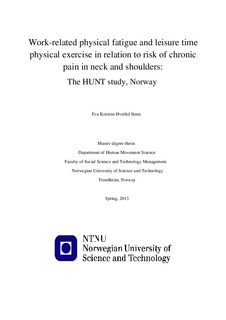| dc.contributor.advisor | Mork, Paul Jarle | nb_NO |
| dc.contributor.advisor | Nilsen, Tom Ivar Lund | nb_NO |
| dc.contributor.advisor | Lier, Ragnhild | nb_NO |
| dc.contributor.author | Steen, Eva Kristine Øvrelid | nb_NO |
| dc.date.accessioned | 2014-12-19T14:44:35Z | |
| dc.date.available | 2014-12-19T14:44:35Z | |
| dc.date.created | 2013-08-15 | nb_NO |
| dc.date.issued | 2013 | nb_NO |
| dc.identifier | 640998 | nb_NO |
| dc.identifier.uri | http://hdl.handle.net/11250/271554 | |
| dc.description.abstract | Background: It is documented that high physical work demands is associated with increased risk of chronic neck/shoulder pain, while regular physical exercise reduces the risk. However, there is limited knowledge about the combined effect of work-related physical fatigue and leisure time physical exercise on risk of chronic pain in neck/shoulders. The first objective of this study was to investigate if work-related physical fatigue and leisure time physical exercise represent independent risk factors for chronic pain in neck/shoulders. The second objective was to investigate the combined effect of work-related physical fatigue and leisure time physical exercise on risk of chronic pain in neck/shoulders.
Methods: The study comprise data on 6,374 women and 8,293 men who participated in the first (1984-86) and second wave (1995-97) of the Nord-Trøndelag Health Study (HUNT) and who reported no chronic pain or physical impairment at baseline in 1984-86. The relative risk (RR) of chronic pain in neck/shoulders at follow-up, associated with work-related physical fatigue and leisure time physical exercise at baseline (HUNT 1) were estimated using a general linear model.
Results: At follow-up, 1,972 (30.9%) women and 1,900 (22.9%) men reported chronic neck/shoulder pain. Work-related physical fatigue was dose-dependently associated with risk of chronic neck/shoulder pain in both women and men (P-trend <0.001). Women and men who experienced work-related physical fatigue "often/always" had RR’s of 1.39 (95% CI 1.17-1.64) and 1.39 (95% CI 1.18-1.64), respectively. Women who reported to be physically active two hours or more per week had a RR of 0.85 (95% CI 0.70-1.03) compared to inactive women. The corresponding RR among men were 0.83 (95% CI 0.70-0.98). The combined analysis showed no interaction between work-related physical fatigue and leisure time physical exercise (P=0.27). However, stratified analysis showed that physically active individuals with work-related physical fatigue "often/always" had lower risk of pain in neck/shoulders compared to inactive individuals with the same level of work-related physical fatigue (P=0.01).
Conclusion: This prospective study indicates that women and men who experience "often/always" work-related physical fatigue have an increased risk of developing chronic pain in neck/shoulders. Regular physical exercise can to some extent reduce the negative effect of frequent work-related physical fatigue on risk of chronic neck/shoulder pain. | nb_NO |
| dc.language | eng | nb_NO |
| dc.publisher | Norges teknisk-naturvitenskapelige universitet, Fakultet for samfunnsvitenskap og teknologiledelse, Institutt for bevegelsesvitenskap | nb_NO |
| dc.title | Work-related physical fatigue and leisure time physical exercise in relation to risk of chronic pain in neck and shoulders: The HUNT study, Norway | nb_NO |
| dc.type | Master thesis | nb_NO |
| dc.contributor.department | Norges teknisk-naturvitenskapelige universitet, Fakultet for samfunnsvitenskap og teknologiledelse, Institutt for bevegelsesvitenskap | nb_NO |
